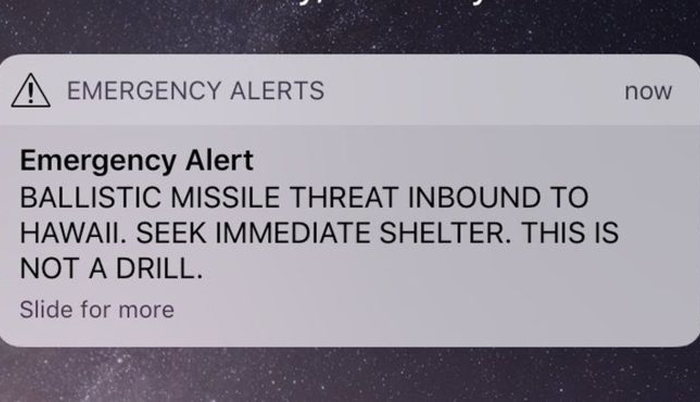![]() Home > America
Home > America
Hawaii Missile Alert: False Alarm Sparks Panic In US State

The message Hawaiians saw on their phones
![]() January 14th, 2018 | 10:32 AM |
January 14th, 2018 | 10:32 AM | ![]() 2359 views
2359 views
UNITED STATES AMERICA
An incoming missile alert plunged residents of Hawaii into panic on Saturday morning before it was declared a false alarm.
Mobile phone users received a message saying: "Ballistic missile threat inbound to Hawaii. Seek immediate shelter. This is not a drill."
State Governor David Ige apologised and said it was caused by an employee pressing the wrong button.
The US government announced there would be a full investigation.
An alert system is in place because of the potential proximity of Hawaii to North Korean missiles.
In December, the state tested its nuclear warning siren for the first time since the end of the Cold War.
How was the alert released?
The false warning message was sent to people's mobile devices, and was also broadcast on television and radio stations.
The phone message notification, all in capital letters, went out at 08:07 (18:07 GMT).
It was corrected by email 18 minutes later but there was no follow-up mobile text for 38 minutes, the Honolulu Star-Advertiser reports.
Governor Ige said human error during one of the thrice-daily shift changes at the the state's Emergency Management Agency (EMA) was to blame for the false alert.
"It was a procedure that occurs at the change of shift where they go through to make sure that the system, that it's working. And an employee pushed the wrong button," he explained.
"It was an inadvertent mistake," said EMA administrator Vern Miyagi. "The change of shift is about three people. That should have been caught... it should not have happened."
Television and radio broadcasts across the state were interrupted with a recorded emergency message instructing people to stay indoors.
"If you are outdoors seek immediate shelter in a building. Remain indoors well away from windows. If you are driving pull safely to the side of the road and seek shelter in a building while laying on the floor. We'll announce when the threat has ended. This is not a drill!"
How did Hawaiians react?
People in the US state have been sharing stories of momentary frenzy and the panic-stricken messages they exchanged with loved ones after they received the alert.
Videos posted on social media appeared to show students at the University of Hawaii running for shelter after the missile threat was issued.
Matt Lopresti, a member of the Hawaiian House of Representatives, was at home when he received the alert on his mobile phone.
He described how he and his family had sought shelter in a bath tub.
"We got our children, grabbed our emergency supplies, put them in our most enclosed room in our house which is our bathroom," he told local broadcaster KGMB.
"We put them in the bath tub, said our prayers, tried to find out what the hell was going on because we didn't hear any alarms, any of the sirens.
"There's not much else you can do in that situation. You know, we did what we could... and I am very angry right now because it shouldn't be this easy to make such a big mistake."
Golfers competing at the US PGA Hawaii Open in Honolulu were also thrown into alarm, with US player Talor Gooch tweeting that "birdies didn't seem too important for a few minutes".
What happened with the button?
After the US military confirmed no missile threat had been detected, and the alert had been released in error, Governor Ige explained:
"It was a procedure that occurs at the change of shift which they go through to make sure that the system is working, and an employee pushed the wrong button."
What is being done to prevent this happening again?
Ajit Pai, chairman of the US Federal Communications Commission, announced the investigation on Twitter.
US President Donald Trump, who was in Florida at the time of the alert, was briefed on the false alert, the White House said.
Senator Mazie Hirono, a Democrat from Hawaii, tweeted: "Today's alert was a false alarm. At a time of heightened tensions, we need to make sure all information released to the community is accurate. We need to get to the bottom of what happened and make sure it never happens again."
Why was Hawaii already on edge?
North Korea's missile and nuclear programme is seen as a growing threat to America. Hawaii is one of the US states closest to North Korea.
In September Pyongyang carried out its sixth nuclear test.
Last month, the Star-Advertiser reported that a missile launched from North Korea could strike Hawaii within 20 minutes of launch.
Didn't something similar happen in Japan this month?
A false earthquake warning was sent to millions of Japanese people's phones on 5 January, causing a brief panic and disrupting Tokyo's transport network.
It turned out to be a false alarm triggered by an error in the earthquake warning system.
Source:
courtesy of BBC NEWS
by BBC News
If you have any stories or news that you would like to share with the global online community, please feel free to share it with us by contacting us directly at [email protected]